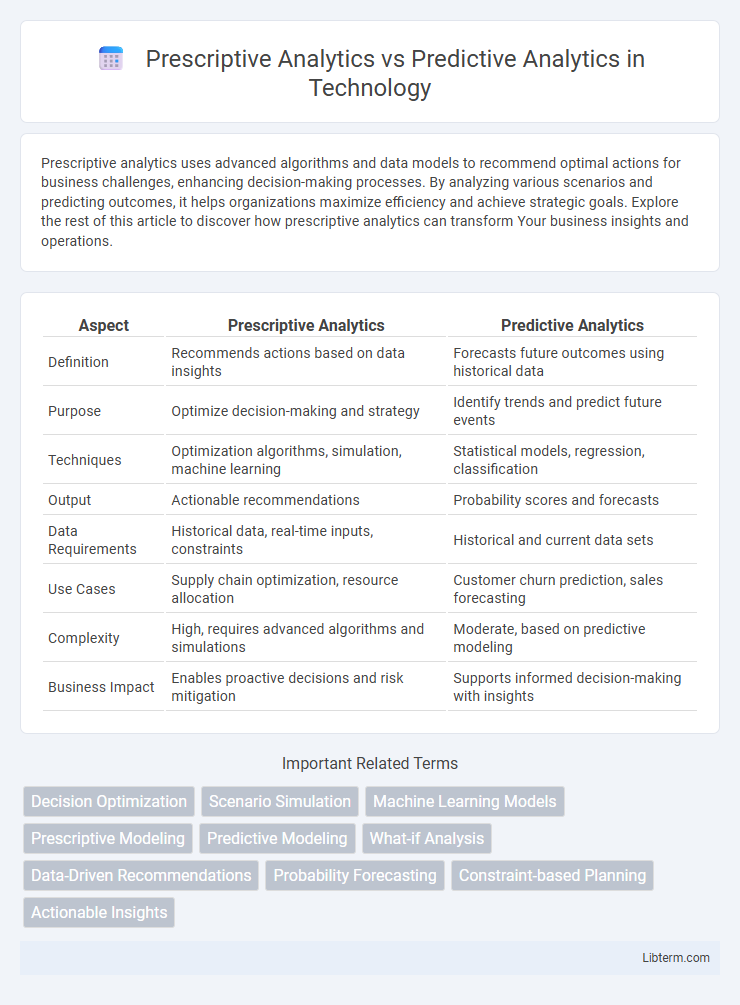Prescriptive analytics uses advanced algorithms and data models to recommend optimal actions for business challenges, enhancing decision-making processes. By analyzing various scenarios and predicting outcomes, it helps organizations maximize efficiency and achieve strategic goals. Explore the rest of this article to discover how prescriptive analytics can transform Your business insights and operations.
Table of Comparison
| Aspect | Prescriptive Analytics | Predictive Analytics |
|---|---|---|
| Definition | Recommends actions based on data insights | Forecasts future outcomes using historical data |
| Purpose | Optimize decision-making and strategy | Identify trends and predict future events |
| Techniques | Optimization algorithms, simulation, machine learning | Statistical models, regression, classification |
| Output | Actionable recommendations | Probability scores and forecasts |
| Data Requirements | Historical data, real-time inputs, constraints | Historical and current data sets |
| Use Cases | Supply chain optimization, resource allocation | Customer churn prediction, sales forecasting |
| Complexity | High, requires advanced algorithms and simulations | Moderate, based on predictive modeling |
| Business Impact | Enables proactive decisions and risk mitigation | Supports informed decision-making with insights |
Introduction to Advanced Analytics
Prescriptive Analytics and Predictive Analytics are core components of advanced analytics, each serving distinct purposes. Predictive Analytics uses historical data and machine learning models to forecast future events, enabling businesses to anticipate outcomes. Prescriptive Analytics goes beyond prediction by providing actionable recommendations to optimize decision-making based on predictive insights, leveraging optimization algorithms and simulation techniques.
Defining Predictive Analytics
Predictive analytics uses statistical models, machine learning algorithms, and historical data to forecast future events and trends, enabling organizations to anticipate customer behavior, market shifts, and operational risks. It identifies patterns and probabilities to support decision-making but does not specify recommended actions. Prescriptive analytics goes beyond prediction by suggesting optimal strategies and solutions based on predictive insights and business goals.
Defining Prescriptive Analytics
Prescriptive Analytics defines a data-driven approach that goes beyond forecasting future outcomes by recommending specific actions to optimize decision-making. It utilizes advanced algorithms, machine learning, and optimization techniques to analyze complex datasets and provide actionable strategies for achieving desired business objectives. Unlike Predictive Analytics, which estimates what might happen, Prescriptive Analytics suggests the best course of action to influence future results effectively.
Key Differences Between Predictive and Prescriptive Analytics
Predictive analytics uses historical data and statistical algorithms to forecast future outcomes, emphasizing what is likely to happen based on patterns and trends. Prescriptive analytics goes beyond prediction by recommending specific actions to achieve desired outcomes, leveraging optimization, simulation models, and machine learning. Key differences include predictive analytics' focus on probability and forecasting, while prescriptive analytics centers on decision-making and actionable insights to guide business strategies.
Core Techniques and Methodologies
Prescriptive analytics employs optimization algorithms, simulation, and decision analysis to recommend specific actions based on predictive insights, while predictive analytics primarily uses statistical models, machine learning, and data mining techniques to forecast future outcomes. Core methodologies in prescriptive analytics include linear programming, Monte Carlo simulation, and heuristic algorithms that guide decision-making under uncertainty. Predictive analytics relies on regression analysis, classification, time series forecasting, and ensemble methods to identify patterns and predict trends from historical data.
Applications of Predictive Analytics
Predictive analytics leverages historical data, machine learning models, and statistical algorithms to forecast future events, enabling businesses to anticipate customer behavior, optimize marketing campaigns, and improve risk management. Common applications include credit scoring in finance, demand forecasting in supply chain management, and predictive maintenance in manufacturing. These insights enhance decision-making by identifying patterns and trends that inform strategic planning and resource allocation.
Applications of Prescriptive Analytics
Prescriptive analytics drives decision-making by recommending specific actions based on predictive insights, optimizing outcomes in sectors like healthcare, finance, and supply chain management. It employs algorithms, simulations, and optimization techniques to determine the best course of action under various scenarios, improving resource allocation and operational efficiency. Industries use prescriptive analytics to enhance personalized treatment plans, optimize investment portfolios, and streamline logistics operations, leading to increased profitability and customer satisfaction.
Benefits and Challenges of Each Approach
Prescriptive analytics offers benefits such as providing actionable recommendations and optimizing decision-making processes using algorithms and simulation models, but it faces challenges including high computational complexity and the need for comprehensive, high-quality data. Predictive analytics excels in forecasting future trends and behaviors using historical data and statistical models, enabling proactive strategies, yet it struggles with the accuracy of predictions when data is incomplete or volatile. Both approaches enhance business intelligence, with prescriptive analytics focusing on decision optimization and predictive analytics emphasizing trend anticipation, requiring careful alignment with organizational goals to manage their limitations effectively.
Choosing the Right Analytics for Your Business
Choosing the right analytics for your business depends on your goals: predictive analytics forecasts future trends using historical data, while prescriptive analytics recommends specific actions to achieve desired outcomes. Predictive models analyze patterns to identify risks and opportunities, ideal for market forecasting and customer behavior prediction. Prescriptive analytics uses optimization and simulation techniques, guiding decision-makers toward the best strategies to maximize efficiency and profitability.
Future Trends in Predictive and Prescriptive Analytics
Future trends in predictive analytics emphasize enhanced machine learning algorithms and real-time data integration for more accurate forecasting across industries. Prescriptive analytics is evolving with advanced optimization techniques and AI-driven decision-making to offer actionable solutions that maximize business outcomes. The convergence of these technologies, powered by big data and cloud computing, is set to drive smarter, faster, and more personalized insights in the near future.
Prescriptive Analytics Infographic

 libterm.com
libterm.com